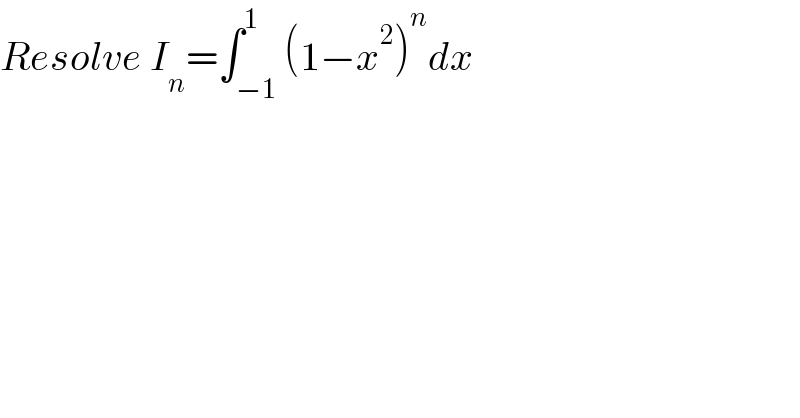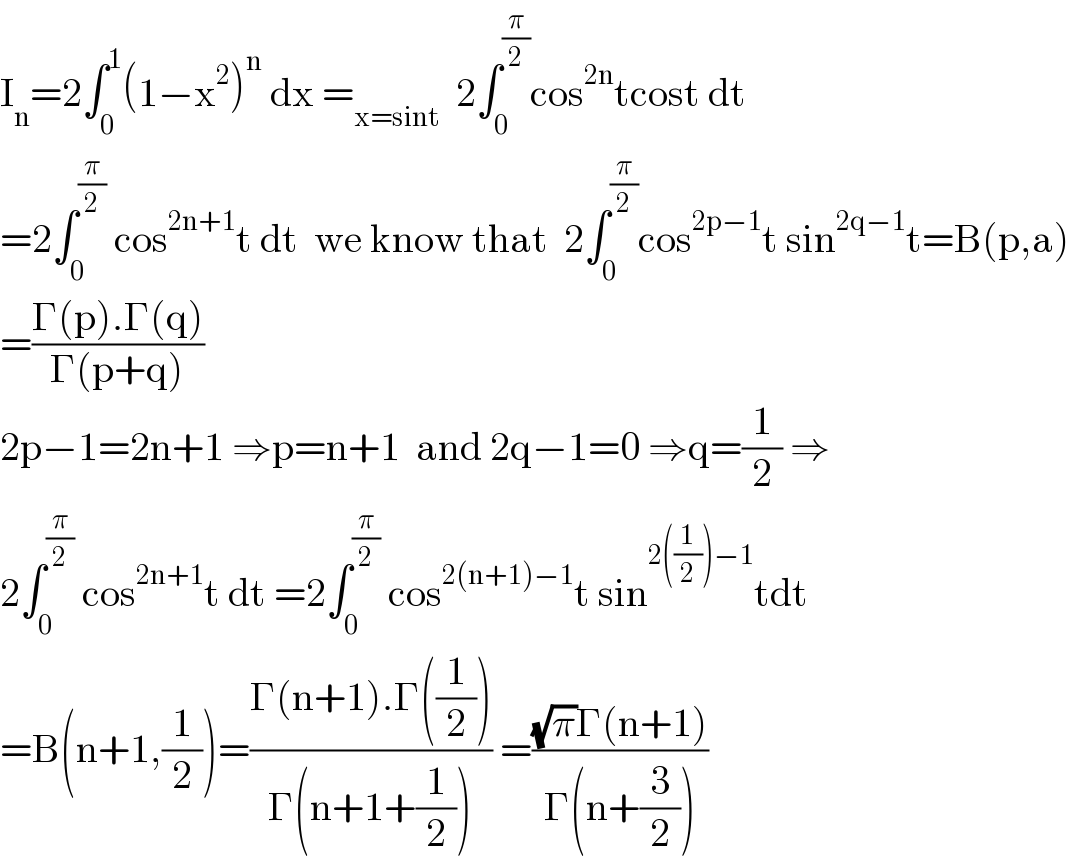
Question Number 159309 by LEKOUMA last updated on 15/Nov/21

$${Resolve}\:{I}_{{n}} =\int_{−\mathrm{1}} ^{\mathrm{1}} \left(\mathrm{1}−{x}^{\mathrm{2}} \right)^{{n}} {dx} \\ $$
Answered by mathmax by abdo last updated on 15/Nov/21

$$\mathrm{I}_{\mathrm{n}} =\mathrm{2}\int_{\mathrm{0}} ^{\mathrm{1}} \left(\mathrm{1}−\mathrm{x}^{\mathrm{2}} \right)^{\mathrm{n}} \:\mathrm{dx}\:=_{\mathrm{x}=\mathrm{sint}} \:\:\mathrm{2}\int_{\mathrm{0}} ^{\frac{\pi}{\mathrm{2}}} \mathrm{cos}^{\mathrm{2n}} \mathrm{tcost}\:\mathrm{dt} \\ $$$$=\mathrm{2}\int_{\mathrm{0}} ^{\frac{\pi}{\mathrm{2}}} \:\mathrm{cos}^{\mathrm{2n}+\mathrm{1}} \mathrm{t}\:\mathrm{dt}\:\:\mathrm{we}\:\mathrm{know}\:\mathrm{that}\:\:\mathrm{2}\int_{\mathrm{0}} ^{\frac{\pi}{\mathrm{2}}} \mathrm{cos}^{\mathrm{2p}−\mathrm{1}} \mathrm{t}\:\mathrm{sin}^{\mathrm{2q}−\mathrm{1}} \mathrm{t}=\mathrm{B}\left(\mathrm{p},\mathrm{a}\right) \\ $$$$=\frac{\Gamma\left(\mathrm{p}\right).\Gamma\left(\mathrm{q}\right)}{\Gamma\left(\mathrm{p}+\mathrm{q}\right)} \\ $$$$\mathrm{2p}−\mathrm{1}=\mathrm{2n}+\mathrm{1}\:\Rightarrow\mathrm{p}=\mathrm{n}+\mathrm{1}\:\:\mathrm{and}\:\mathrm{2q}−\mathrm{1}=\mathrm{0}\:\Rightarrow\mathrm{q}=\frac{\mathrm{1}}{\mathrm{2}}\:\Rightarrow \\ $$$$\mathrm{2}\int_{\mathrm{0}} ^{\frac{\pi}{\mathrm{2}}} \:\mathrm{cos}^{\mathrm{2n}+\mathrm{1}} \mathrm{t}\:\mathrm{dt}\:=\mathrm{2}\int_{\mathrm{0}} ^{\frac{\pi}{\mathrm{2}}} \:\mathrm{cos}^{\mathrm{2}\left(\mathrm{n}+\mathrm{1}\right)−\mathrm{1}} \mathrm{t}\:\mathrm{sin}^{\mathrm{2}\left(\frac{\mathrm{1}}{\mathrm{2}}\right)−\mathrm{1}} \mathrm{tdt} \\ $$$$=\mathrm{B}\left(\mathrm{n}+\mathrm{1},\frac{\mathrm{1}}{\mathrm{2}}\right)=\frac{\Gamma\left(\mathrm{n}+\mathrm{1}\right).\Gamma\left(\frac{\mathrm{1}}{\mathrm{2}}\right)}{\Gamma\left(\mathrm{n}+\mathrm{1}+\frac{\mathrm{1}}{\mathrm{2}}\right)}\:=\frac{\sqrt{\pi}\Gamma\left(\mathrm{n}+\mathrm{1}\right)}{\Gamma\left(\mathrm{n}+\frac{\mathrm{3}}{\mathrm{2}}\right)} \\ $$
